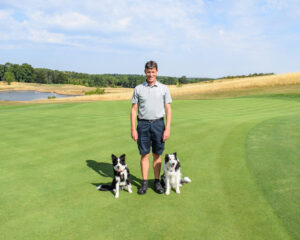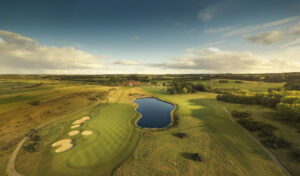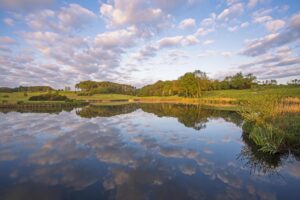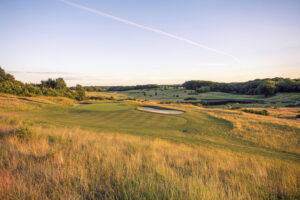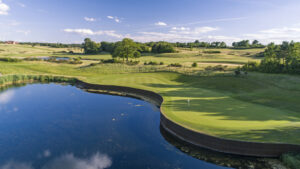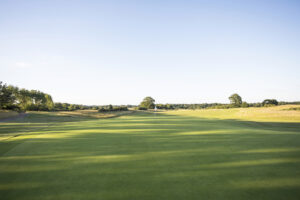Meet the golf courses & estate manager: Lee Sayers
Related Articles
From London Golf Club in Kent, Lee talks about overcoming the challenges of dealing with increased golf participation, lockdowns and crane-fly larvae in recent years.
Can you give a description of your background and how long you’ve now been at the golf club?
Prior to arriving at London Golf Club for the first time, I worked in Australia for three years, greenkeeping mostly at Cottesloe Golf Club in Swanbourne, Western Australia. I’m now in my third stint at the club and returned in 2017, having previously worked here from 1994 to 1998 and 2000 to 2003, leaving each time to manage other courses. I now have more than 30 years’ experience, but the role has changed since I started and, nowadays, the time in the job alone is not as important as it used to be. If you want to get on and if you’re committed and you’re bright, you can learn a lot quickly.
How has the venue evolved in recent years? What projects have you carried out?
In the 30 years since construction, the site has matured considerably, and our membership profile has changed in that time to better suit our business. Since I have been here, we have had improvements made to our pump house, as well as sprinkler-head change-outs, which have made priority surfaces more sustainable for us. In 2019, we had a large storm that flooded our courses and washed out every bunker on the site.
As a result, all 179 bunkers (two hectares) were fitted with new pipework and gravel as well as new sand. It was an extensive project carried out by contractors, but we remained open for play. Last year, we enjoyed the honour of hosting the DP World Tour Cazoo Classic on The Heritage course. Our team, with the help of volunteers (some of which were former greenkeepers at the club), prepared the course with only a few months’ notice. It was the first time our courses had hosted a main Tour event since 2014, so it was all hands on deck, especially coming out of the pandemic lockdowns.
What were the biggest challenges you faced in lockdown?
Whilst the business was closed to golfers, we still had two enormous golf courses with 60 hectares of grass that needed to be cut and maintained. We had to work with a small team at times but we managed, thanks to the great people and team spirit that we have at the club. Lockdown did give us the opportunity to fit in some extra tasks which are usually difficult around golf, but each lockdown also brought about uncertainty for us as a business and for our team members. It was always a guessing game of when we would open again.
What growth has the club seen by way of members and play since then, and what challenges has this brought?
After the lockdowns, our tee sheets were booked solid every day. As the whole industry experienced a golf boom after the lockdown period, it was a challenge to keep up with the incredible number of ‘new’ golfers and, for the first time in the club’s history, we implemented a waiting list for membership. Over time, we have noticed how this has impacted things such as course etiquette and how this affects the greenkeeping workload. For example, during the pandemic, golfers didn’t have to rake bunkers as the rakes were removed, but this habit has unfortunately spilled into the membership today.
Crane-fly larvae has been a major issue on UK golf courses lately, has this impacted you and how have you dealt with it?
Crane-fly larvae have affected our site. The increase in numbers has, in places, reached a threshold where damage has occurred from the grubs themselves and secondary predators damaging the playing surface to access the larvae. But we’ve been successful in keeping disruption to a minimum, partly with control from Acelepryn and also by providing good aeration, adequate nutritional levels and moisture, and well-planted seed to repair the affected areas. Going forward, it will be important to have the tools and budget for quick and effective ways of recovering turf whether it be grub damage, high levels of play, disease or worm-cast smearing.
What advice would you give to youngsters starting out and wanting to pursue a career in the profession?
Becoming a greenkeeper can be so rewarding but I would advise anyone starting out to gain as much experience as they can. People should always be looking to be on an upward learning curve and, if it plateaus off, then change something. It’s also important to find a job where the maintenance department is professionally run with adequate resources. Without either of these, the frustrations might detract from the most enjoyable elements of the job.
What changes do you think need to be made to benefit the industry sector and profession of the greenkeeper?
I would urge any greenkeeper not to put up with unreasonable working conditions or expectations. Find an employer that provides adequate resources and who is keen to develop and invest in you so that they can reap the rewards as your knowledge and experience grows.

